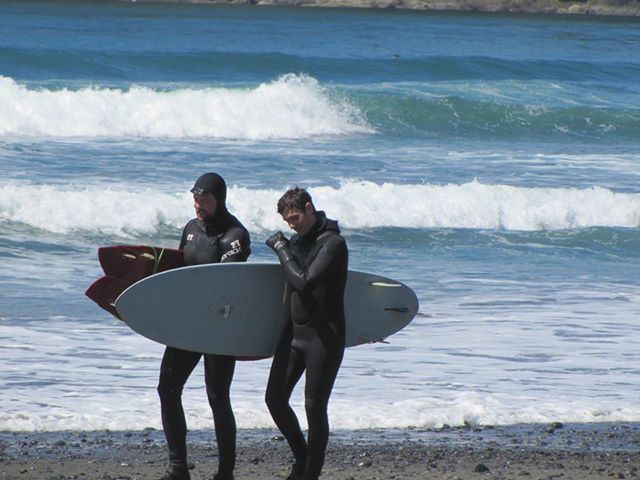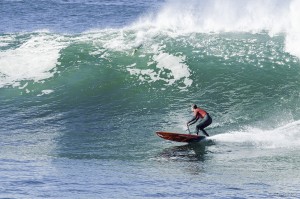
Our friends & partners at Earth Economics recently released a groundbreaking report for the Washington State Recreation and Conservation Office that confirms we really enjoy playing outdoors here in our beautiful state. From hikes in the desert to a ski run down a mountain side to clam digging at the ocean, Washington State residents have numerous choices when deciding what to do outside. The state’s rich outdoor recreation choices also provide jobs to many families and businesses. This study quantifies the contribution of outdoor recreation to Washington State’s economy and way of life.
 Surfrider member Matt Spencer locked in on a Westport peak during the annual Clean Water Classic. Photo credit Mathew Marino
Surfrider member Matt Spencer locked in on a Westport peak during the annual Clean Water Classic. Photo credit Mathew Marino
The benefits of Washington’s outdoor recreation industry go beyond supporting jobs to include creating a way of life. It is estimated that Washingtonians, on average, spend 56 days a year recreating outdoors. According to the recreation surveys and public land records used in this study, there were a total of about 446 million participant days a year spent on outdoor recreation in Washington, resulting in $21.6 billion dollars in annual expenditures.
Expenditures were highest for recreation associated with public waters. Water recreation includes a number of activities with high trip and equipment expenditures, especially motorized boating. Ranking second were special events such as sports tournaments and races, which generally involve fees and attract overnight stays. Ranking third was recreation on private lands, which includes expensive recreation activities such as golf, skiing, and off-highway vehicle riding and hunting, which often occur on private timberland. Local parks are the most common place for people to visit as well as the most accessible and least costly destination.
Nearly 200,000 jobs are supported in Washington State as a result of outdoor recreation spending. A total of about 122,600 jobs, or about 62 percent, are from expenditures associated with outdoor recreation on public lands. These numbers compare to other major employers in the state such as the information technology (191,000 jobs supported) or the aerospace industry (94,200 jobs supported). Outdoor recreation-related jobs include both full-time and part-time jobs in sectors such as food and beverage services, retail, and general recreational services (Figure 2). In general, these sectors are made up of many businesses ranging from small local shops to large retailers such as REI.
Detailed results for recreation-related expenditures by land type are provided for Washington State as a whole, as well as for counties and legislative districts. These results show that outdoor recreation markets play an important role bridging urban and rural communities. The recreation market is unquestionably one of the largest markets in the state for moving income from urban to rural areas and building sustainable jobs in rural Washington State. Out-of-county visitors create a redistribution of wealth between the place of origin and the destination for recreation. For example, Seattle residents going to Leavenworth for outdoor recreation redistributes income from Seattle to Leavenworth. These dynamics are important to many rural counties.
Out-of-state visitors play an important role in the economics of outdoor recreation. Out-of-state visitors accounted for an estimated 12 percent of all participant days and 27 percent of total outdoor recreation spending. Every dollar spent by an out-of-state traveler in Washington generates $1.36 in economic impacts, resulting in a total of $4.6 billion in new money circulating in the state's economy. A total of 46,430 jobs or 23 percent of total outdoor recreation supported jobs in Washington are a result of expenditures by out-of-state visitors. The results of the out-of-state visitor impact analysis highlights the importance of promoting outdoor recreation in Washington beyond state borders.
In addition to the monetary contribution of outdoor recreation to Washington's economy, there are a number of other benefits not accounted for within traditional economic analysis. These benefits include the satisfaction and increase in general quality of life people get from engaging in outdoor recreation and from the ecosystem services recreational lands provide. Trees, water, and animals provide ecosystem goods and services such as swimmable water, habitat, and aesthetic beauty. Washington’s 23 million acres of public land provide many of these benefits. The combined total estimated value of these nonmarket benefits is between $134 billion and $248 billion a year.
There is much more to the story of outdoor recreation and its importance to Washington State than is revealed in the economic analyses presented in this report. Outdoor recreation markets help connect urban and rural communities and, as identified by the Governor’s Blue Ribbon Task Force on Outdoor Recreation in its final report (2014), the benefits of outdoor recreation translate into “healthier kids, lowered health care costs, less absenteeism in the work place, and decreases in juvenile crime." The Task Force also recognized that "recreating outside leads to people placing a value on natural places and believing it is important to keep them available for today's and future generations.” For those reasons and all of the others presented in this report, investment in outdoor recreation yields tremendous returns.
Download the full report here-> Economic Analysis of Outdoor Recreation in Washington State


